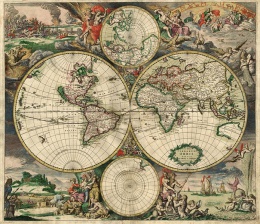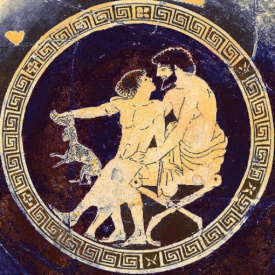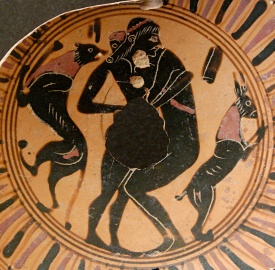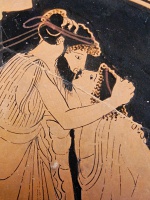Ancient Greece: Difference between revisions
No edit summary |
|||
| (55 intermediate revisions by 2 users not shown) | |||
| Line 1: | Line 1: | ||
{{History}} | |||
''' | In '''ancient Greece''', boylove traditionally took the form of a relationship with educational and erotic components between an adult man, called the ''[[erastes]]'' ("lover"; [[Greece|Greek]]: ἐραστής, pl. ἐρασταί, ''erastai''), and an [[Adolescence|adolescent]] boy, kwown as the ''[[eromenos]]'' ("beloved"; [[Greece|Greek]]: ἐρώμενος, pl. ἐρώμενοι, ''eromenoi''). Homosexual relationships with youths who had entered adulthood (signaled by the growth of a beard) were commonly disapproved. | ||
==Courtship== | ==Courtship== | ||
[[File:Erastes and Eromenos.jpg|thumb|275px|left|Erastes and eromenos: The man made the traditional gift of a hare and embraces the boy, who turns to kiss him. Attic red-figure kylix by the Antiphon Painter, c. 490 BC. Tarquinia, Museo Nazionale Tarquiniense, 701.]] | |||
According to Aeschines, Athenian fathers would pray that their sons would be handsome and attractive, with the full knowledge that they would then attract the attention of men and "be the objects of fights because of erotic passions". | |||
Once a man had selected a boy from the palaestra, the next step would be to take him to the ''andreion'', a sort of men's club or meeting hall. | The most common place where men would go to meet boys was the ''[[palaestra]]'' (the Greek word for their version of a gymnasium), where the former watched the latter exercising. This being the case, only leisured aristocrats with time on their hands probably really engaged in homosexual affairs. Once a man had selected a boy from the ''palaestra'', the next step would be to take him to the ''andreion'', a sort of men's club or meeting hall. | ||
In Crete, in order for the suitor, known as ''philetor'', to carry out a ritual abduction, the youth's father had to approve him as worthy of the honor. The ''philetor'' went away with the adolescent for two months into the countryside, where they hunted and feasted. At the end of this time, the ''philetor'' presented the youth with three contractually required gifts: military attire, an ox and a drinking cup. Other costly gifts followed. | |||
Copulation with the ''erastes'' was a choice the boy could make; it was not required. | |||
Typically, after their sexual relationship had ended and the young man had married, the older man and his protégé would remain on close terms throughout their life. | |||
== | == Social aspects == | ||
[[ | [[Pederasty]] was the idealized form of an age-structured homoeroticism that had other, less idealized manifestations, such as prostitution or the sexual use of slave boys. Paying free youths for sex was prohibited. Free youths who did behave as prostitutes and sold their favors, outside of the socially sanctioned gifts, were ridiculed, and later in life might be prohibited from performing certain official functions. | ||
Pederasty as an institution in ancient Greek society assisted in forming strong life-long bonds between the ''erastes'' and ''eromenos'', who often would go into battle together. It served as a type of apprenticeship where the adult male was expected to teach the young man or to provide for his education, and to give him certain appropriate ceremonial gifts.<ref>[http://en.wikipedia.org/wiki/Pederasty#The_Greeks Pederasty (Wikipedia)]</ref> The adult lover would assist in the process of the acculturation and integration of the youth into adult life. Pederastic myths often depict the process of initiation and transformation of the boy into adult male life<ref>[http://en.wikipedia.org/wiki/Cyparissus Cyparissus (Wikipedia)]</ref> through the allegorical "death and transfiguration" of the youth, signifying that he was no longer a boy but a free adult ready to enter into the rank, responsibility, and privilege of adult society. | |||
== Sexual practices == | |||
[[File:Pederastic erotic scene.jpg|thumb|275px|left|Pederastic erotic scene: Intercrural sex between a teenager and a young man. Fragment of an Attic black-figure cup, c. 550–525 BC. Paris, Musée du Louvre, F 85 Bis.]] | |||
Vase paintings and an obsession with the beloved's appealing thighs in poetry indicate that when the pederastic couple engaged in sex acts, the preferred form was [[Intercrural intercourse (dictionary)|intercrural]]. To preserve his dignity and honor, the ''eromenos'' limits the man who desires him to penetration between closed thighs. | |||
[[Anal intercourse|Anal sex]] is depicted, but far more rarely. The evidence is not explicit and is open to interpretation. Some vase paintings, which William A. Percy considers a fourth type of pederastic scene in addition to John Beazley's three, show the ''erastes'' seated with an erection and the ''eromenos'' either approaching or climbing into his lap. The composition of these scenes is the same as that for depictions of women mounting men who are seated and aroused for intercourse. | |||
As a cultural norm considered apart from personal preference, anal penetration was perhaps seen as passive and unmanly for a free boy. Oral sex is likewise not depicted, or is indicated only indirectly; anal or oral penetration may have been reserved for prostitutes or slaves; however, the extent to which these practices were engaged in by men and free youths is unknown. | |||
{{clr}} | {{clr}} | ||
==References== | |||
{{reflist}} | |||
*Stephen Batchelor, ''The Ancient Greeks for Dummies'' (John Wiley & Sons, 2008). ISBN 978-0-470-98787-2 | |||
==See also== | ==See also== | ||
*[[ | *[[Cretan pederasty]] | ||
*[[Ganymede (mythology)]] | *[[Ganymede (mythology)]] | ||
*[[Hyacinth (mythology)]] | *[[Hyacinth (mythology)]] | ||
*[[ | *[[Symposium]] | ||
== External links == | == External links == | ||
* [http://en.wikipedia.org/wiki/Pederasty_in_Ancient_Greece Pederasty in ancient Greece (Wikipedia)] | * [http://en.wikipedia.org/wiki/Pederasty_in_Ancient_Greece Pederasty in ancient Greece (Wikipedia)] | ||
{{Navbox Ancient Greece}} | |||
{{ | |||
[[Category:Ancient Greece]] | [[Category:Ancient Greece]] | ||
[[Category:Greece]] | [[Category:Greece]] | ||
Latest revision as of 22:32, 2 July 2022
| Part of the boylove history series |
 |
| Portal:History |
In ancient Greece, boylove traditionally took the form of a relationship with educational and erotic components between an adult man, called the erastes ("lover"; Greek: ἐραστής, pl. ἐρασταί, erastai), and an adolescent boy, kwown as the eromenos ("beloved"; Greek: ἐρώμενος, pl. ἐρώμενοι, eromenoi). Homosexual relationships with youths who had entered adulthood (signaled by the growth of a beard) were commonly disapproved.
Courtship

According to Aeschines, Athenian fathers would pray that their sons would be handsome and attractive, with the full knowledge that they would then attract the attention of men and "be the objects of fights because of erotic passions".
The most common place where men would go to meet boys was the palaestra (the Greek word for their version of a gymnasium), where the former watched the latter exercising. This being the case, only leisured aristocrats with time on their hands probably really engaged in homosexual affairs. Once a man had selected a boy from the palaestra, the next step would be to take him to the andreion, a sort of men's club or meeting hall.
In Crete, in order for the suitor, known as philetor, to carry out a ritual abduction, the youth's father had to approve him as worthy of the honor. The philetor went away with the adolescent for two months into the countryside, where they hunted and feasted. At the end of this time, the philetor presented the youth with three contractually required gifts: military attire, an ox and a drinking cup. Other costly gifts followed.
Copulation with the erastes was a choice the boy could make; it was not required.
Typically, after their sexual relationship had ended and the young man had married, the older man and his protégé would remain on close terms throughout their life.
Social aspects
Pederasty was the idealized form of an age-structured homoeroticism that had other, less idealized manifestations, such as prostitution or the sexual use of slave boys. Paying free youths for sex was prohibited. Free youths who did behave as prostitutes and sold their favors, outside of the socially sanctioned gifts, were ridiculed, and later in life might be prohibited from performing certain official functions.
Pederasty as an institution in ancient Greek society assisted in forming strong life-long bonds between the erastes and eromenos, who often would go into battle together. It served as a type of apprenticeship where the adult male was expected to teach the young man or to provide for his education, and to give him certain appropriate ceremonial gifts.[1] The adult lover would assist in the process of the acculturation and integration of the youth into adult life. Pederastic myths often depict the process of initiation and transformation of the boy into adult male life[2] through the allegorical "death and transfiguration" of the youth, signifying that he was no longer a boy but a free adult ready to enter into the rank, responsibility, and privilege of adult society.
Sexual practices

Vase paintings and an obsession with the beloved's appealing thighs in poetry indicate that when the pederastic couple engaged in sex acts, the preferred form was intercrural. To preserve his dignity and honor, the eromenos limits the man who desires him to penetration between closed thighs.
Anal sex is depicted, but far more rarely. The evidence is not explicit and is open to interpretation. Some vase paintings, which William A. Percy considers a fourth type of pederastic scene in addition to John Beazley's three, show the erastes seated with an erection and the eromenos either approaching or climbing into his lap. The composition of these scenes is the same as that for depictions of women mounting men who are seated and aroused for intercourse.
As a cultural norm considered apart from personal preference, anal penetration was perhaps seen as passive and unmanly for a free boy. Oral sex is likewise not depicted, or is indicated only indirectly; anal or oral penetration may have been reserved for prostitutes or slaves; however, the extent to which these practices were engaged in by men and free youths is unknown.
References
- Stephen Batchelor, The Ancient Greeks for Dummies (John Wiley & Sons, 2008). ISBN 978-0-470-98787-2

